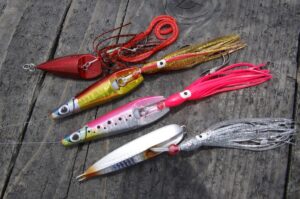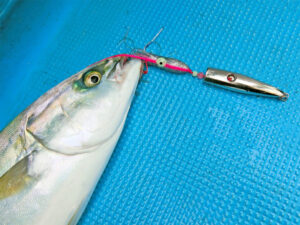Japan’s Favorite Fish; Madai
Tai is the favorite fish for Japanese people. There are many fish called -tai or -dai (“dai” is the variant pronunciation of “tai”, so here tai and dai means the same.) There are Kuro-dai, Me-dai, Fuefuki-dai, etc. You can say that Tai is the typical image of fish for Japanese people. And it is highly likely that, when a Japanese person is asked to draw a picture of a fish, then this person draws the tai-like fish. For us, among these tai-like fish, the most important one or the typical tai is Madai (Red snapper, Pagus major.) “Madai” means literally “the true Tai”.
Madai is a very important fish for Japanese culture. And it made one of the most attractive target fish for anglers.
In this article, after describing the species details, I will explain the fishing styles for Madai. In the later part, the historical background of Japan's favorite fish, with the history of fishing for Madai.
The Species
Madai (Red snapper, Pagus major) is a species in a Sparidae family. As for the angling target, New Zealand’s red snapper is very famous for its gigantic size. This New Zealand one is Pagrus Auratus. This Pagrus Auratus is living in Japan, as well as Oceanian coasts. Among scientists, there are arguments that these two species are sharing the common origin and subspecies.
The Red snapper in the US is a different species. This fish, often caught in the southern Atlantic coast of the US, and in the Caribbean Sea, is Northern Red Snapper (Lutjanus campechanus). This snapper is a different species from the Japanese one.
Madai is living in the Northwest Pacific, ranging from the South China Sea to the northward up to Japan. Almost all the sea surrounding Japan has this fish, except the very south of Okinawa Islands and the northern tips of Hokkaido.
They spawn in the shallower area, on the seaweeds, in the spring or summer time. Spawning timing in the Tokyo area is in April or May. The hatched fish stay in the shallower areas, and they gradually go deeper. It dwells in the depth from 20 m to 200 m. Once an individual finds the place to live in a certain depth, then it tends to stay there, except for the spawning time.
It is said that Madai grows to 15 cm in its first year, 25 cm in the second, and it becomes 40 cm in 5 years, and 60 cm in 10 years. For anglers, over 1 m size is the trophy in Madai. It means that the trophy fish may be about 25 - 30 years old.
Madai is living on various types of foods. The grown-ups are eating crustaceans, smaller fish, shells and sea urchins. In one study, the most of the food which Madai was eating, in the summertime near Hoso Island, in the Setouchi area, was Gammaridea. The second important food was sea worms, and these sea worms became more important in the late summer.
Of course, the kinds of foods are different, depending on the seasons and the available food sources.
Fishing for Madai
Since Madai is a very accessible fish in Japan, there are many different kinds of angling for it. Here are the currently popular styles.
- Fish with chumming (offshore boat)
- Tenya (offshore boat)
- Tai Rubber (offshore boat)
- Jigging (offshore boat)
- Iso fishing (shore, Fukase or Kago style)
As Madai is living in deep areas mostly, deeper than 20 m, the major methods are offshore boat fishing.
The 1st one is the fishing style using chumming.
It uses the electric reels with the parabolic action rods, which can hold sinkers from 100 g to 200g (30 - 50 gou).
The rig has a kind of a spreader or a balance boom, with the feeder cage (pink colored in the above image). This feeder holds chumming and spreads chum with jerkings of the rod. This cage has an integrated sinker.
We use krills for chumming and for hook bait. The concept is that the hooked bait drifts with the spread chumming in the flowing current. Then the fish mistakenly bite on the hooked bait amid clouds of chumming.
The second method, Tenya, and the third method, Tai Rubber, are described in the articles below.
About Tenya “Tenya; Japanese Traditional Jig head?”
About Tai Rubber “Fishing with Tai Rubber”
The Jigging for Madai is possible when the fish are feeding on small fish, such as sardines. The timing varies depending on the area and the movement of bait fish. There are many anglers who bring Tai Rubber with jigs, to deal with different situations, since often movements of bait fish are inconsistent. Jig weights are from 40 g to 120 g. The line is braided lines, between 0.15 mm to 0.19 mm thickness (0.8 gou to 1.2 gou).
History of relationship between Madai and Japanese people
From the distribution of Madai, we can imagine that this fish has been a very accessible fish for ancient Japanese people.
In the ruins of living spaces from the Jomon period, we could find the remains of fish bones. And these are of Sparidae species, including Madai.
In 712, the Japanese Mythology, Kojiki, was compiled. It had one episode, mentioning about Madai.
Once upon a time, Yamasachi-hiko (an enchanted hunter) lost the fishing hook had borrowed from Umisachi-hiko (an enchanted fisherman). Then Yamasachi-hiko visited the god of the sea, to search for the hook in the bottom of the sea. The god of the sea found the hook in the mouth of Madai.
With the preference of colors which Japanese came to have, the fish would receive special treatment for its color.
In the Heian period (794 - 1185,) there were two powers, and one side had red flags and the other side had the white flags as their symbol colors. Also, it was said that the red had been preferred by the emperors at the period.
With this favor in red and white colors, Madai became the symbolic fish. Then it would be the fish for noble people and foods for special religious rituals.
Specifically, in the Engishiki, a book about laws and regulations, written in 927, you can see Madai was delivered from Izumi (current Osaka), Ise (current Mie), and Mikawa (current Aichi), as a ritual food of the emperor.
Additionally, in a record compiled in 1191, that explained about the ceremonies, Madai was mentioned to be served for the gifts for gods. At that time, Madai was carried as dried fish.
The popularity continued until the Edo period.
The color of red and white signified good luck, and Madai was often used for the food for festive days (festival, anniversary, wedding, etc.) There was even a cookbook only for cuisines with Madai.
And Madai has been the favorite for modern Japanese people. We started the farming of Madai, and the fish became more affordable than ever, fortunately.
Old fishing rigs for Madai
Since this fish is living in the deeper water, the main method to fish was from the boat.
It was difficult to do fishing with a fishing line. But there was some rare occasion when they could enjoy hand line fishing for Madai, in the Edo period.
Please see that the fisherman in the image above is using the normal fishing line. The words in the image are saying that the fish caught by handline has better taste than the one caught by nets.
The fishing for Madai was made much easier with the invention of the leaded handline. This line had a kind of split shot fixed on the line with certain distances between. With this, fishermans could send their baits deeper easily, and it made their probability to get fish much higher.
According to the report published in 1912, the Madai fishing was mostly done by nets or the longline fishing. There were areas, such as Saga, Nagasaki, and Tsushima Island, where handling fishing for Madai was done all year round.
With this rig, Madai fishing became a very popular style in many places in Japan.
To show its popularity, in the 1900's, there were already many shapes of hooks dedicated to Madai fishing. The image below shows various shapes.
I hope this article gave you an brief overview on Madai, in Japan.
It is just a species of fish, but in our culture, fish eating culture, it is more than a fish. Hopefully, you can understand the cultural background of the popularity of Madai fishing, as well as the modern methods to catch it.
One funny picture of Madai, from the Edo period.
In the image below, of the Edo comical story, fish characters are discussing. You can see the Madai-man in the front left.


One thought on “Japan’s Favorite Fish; Madai”